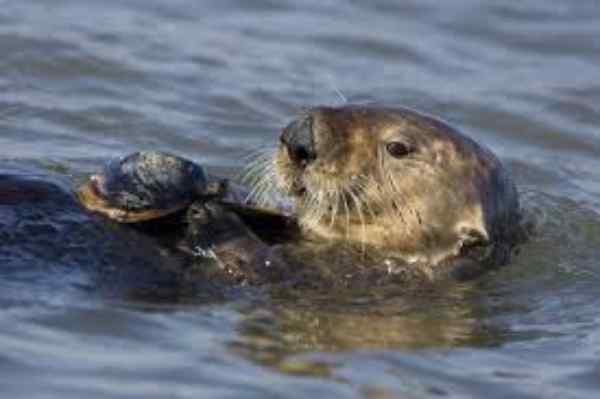While otters are commonly regarded as adorable and playful creatures, their dining habits may not be as endearing to the animals they prey upon. As carnivorous beings, otters possess impressive hunting skills and primarily rely on fish as their preferred meal. However, their diet varies depending on the season and geographical location, encompassing a diverse range of aquatic prey. This led me to question whether otters also include turtles in their menu.
Table of Contents
Upon conducting research, I discovered that otters do consume turtles, despite fish, crabs, crayfish, and various amphibians forming their main food sources. These resourceful creatures are not particularly selective eaters and, in addition to turtles, they may also target and devour birds, rodents, and even snakes whenever the opportunity arises.
In this article, we will delve into the potential prey species of otters, with a specific focus on their interaction with turtles.
Do Otters Eat Turtles?

While turtles may not be the primary source of meat for otters, these resourceful creatures will not hesitate to hunt and consume turtles if the opportunity arises. Otters are renowned for their opportunistic eating habits, adapting to different wildlife when fish is unavailable.
To sustain themselves, otters must consume up to 25% of their total body weight on a daily basis. This drives them to spend approximately 5 hours each day in pursuit of their prey, employing their keen senses to detect and capture potential meals.
Related Article: Can Otters Breathe Underwater? Unveiling the Truth
When it comes to turtles, although it is less common for otters to feed on them, occasional predation does occur. Witnessing otters consuming and killing turtles can be distressing. Given an opportunity, an otter will stealthily approach the turtle, grasp it by its shell, and commence devouring it while it is still alive. Once the turtle becomes immobile, the otter may carry it to land to finish the meal outside of the water.
What Other Animals Eat Turtles?

Shallow ponds and streams serve as habitats for snapping turtles, which are renowned as the heaviest freshwater turtles. These omnivorous creatures have a diverse diet that includes both plant and animal matter. As a result, adult snapping turtles have relatively few natural predators. This is primarily due to their substantial size and impressive defensive capabilities.
However, there are a select few animals known to kill and prey upon snapping turtles:
- Coyotes: These adaptable canines are among the predators that may target snapping turtles in their natural habitats.
- American black bears: With their strength and opportunistic nature, American black bears are capable of hunting and consuming snapping turtles.
- American alligators: In areas where their ranges overlap, American alligators can pose a threat to snapping turtles, considering their ability to hunt and feed on them.
- Other snapping turtles: Interestingly, larger snapping turtles have been observed preying on smaller individuals of their own species, resulting in intraspecific predation.
These predators demonstrate notable exceptions to the relative safety enjoyed by adult snapping turtles in their environments.
Do Otters Have Any Predators?
Otters, while formidable creatures, do not hold the title of the most dominant or powerful predators in the wild. However, they often act collectively to defend themselves against threats, leveraging their numbers as a defence mechanism. Nonetheless, every predator has its own predators, as is the nature of the natural world.

Apart from humans, who can be considered the primary predators of otters, here are some of the main adversaries that otters may encounter in both land and water habitats:
- Eagles: These aerial predators, with their sharp talons and keen eyesight, pose a threat to otters, particularly when they are near bodies of water.
- Coyotes: Opportunistic and agile, coyotes are known to hunt small mammals, including otters when the opportunity arises.
- Bobcats: With their stealth and agility, bobcats can be potential predators of otters, especially in habitats where their ranges overlap.
- Wolves: In certain regions, where otters and wolves coexist, these apex predators may prey upon otters.
- Bears: Although encounters are rare, bears, with their strength and omnivorous diet, can potentially pose a threat to otters.
- Whales: In marine environments, larger whale species may inadvertently pose a danger to otters, especially during feeding or migration.
- Sharks: In coastal areas, otters may encounter sharks, which are apex predators in the marine ecosystem.
- Sea Lions: Competition for resources and territorial disputes can lead to confrontations between sea lions and otters.
While otters are formidable and adaptable predators, they too face natural challenges and potential predation from a variety of other species in their respective habitats.
Related Article: Beaver vs Otter: 5 Notable Distinctions
Final Words
As much as they may appear adorable, otters can be fierce and predatory creatures. They have razor-sharp claws and a powerful bite that enables them to take on even the mightiest of foes. It’s well-known that the otter’s diet primarily consists of fish, but they won’t hesitate to take down a turtle if given the chance. These playful aquatic animals may seem harmless, but they’re not picky eaters and will go to great lengths to find food when they’re hungry. The lesson here? Just because something looks cute and cuddly doesn’t mean it’s not capable of being a formidable predator in the wild.
Reference:
- https://www.nwf.org/Educational-Resources/Wildlife-Guide/Mammals/north-american-river-otter#:~
- https://nationalzoo.si.edu/animals/north-american-river-otter
- https://www.crittercontrol.com/wildlife/otter/are-otters-dangerous

Jeevan Kodiyan
An animal enthusiast with an interest in zoology, studying the behavior and activities of animals in the wild habitat. I work on research projects related to species conservation and endangered species protection. I also leverage zoology to become an educator, educating others about the importance of protecting our natural environment and the beauty of animals in their natural habitats.









